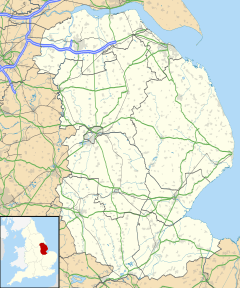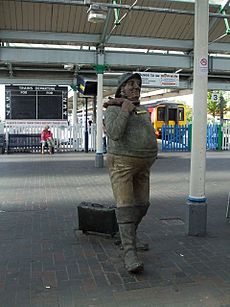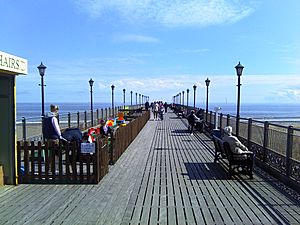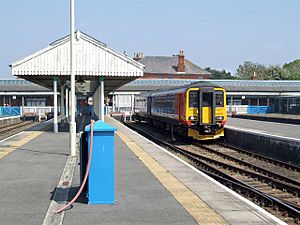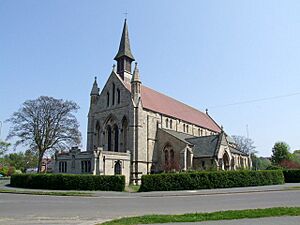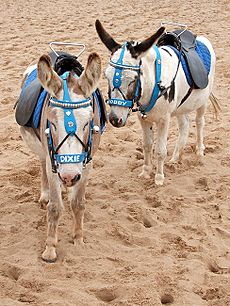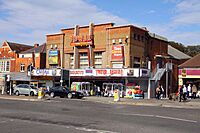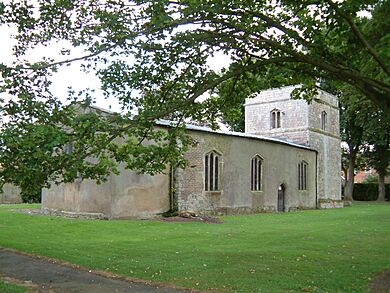Skegness facts for kids
Quick facts for kids Skegness |
|
|---|---|
| Town | |
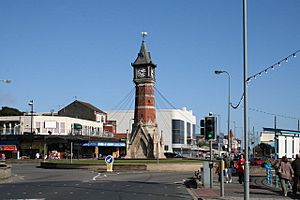 Skegness clock tower and seafront amusements |
|
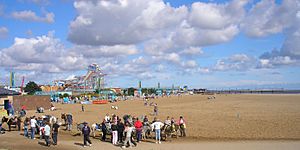 The beach with the pier in the background |
|
| Population | 21,128 (2021 Census) |
| OS grid reference | TF5663 |
| • London | 115 mi (185 km) S |
| Civil parish |
|
| District | |
| Shire county | |
| Region | |
| Country | England |
| Sovereign state | United Kingdom |
| Post town | SKEGNESS |
| Postcode district | PE24, PE25 |
| Dialling code | 01754 |
| Police | Lincolnshire |
| Fire | Lincolnshire |
| Ambulance | East Midlands |
| EU Parliament | East Midlands |
| UK Parliament |
|
Skegness is a fun seaside town in Lincolnshire, England. It sits right on the Lincolnshire coast by the North Sea. Skegness is about 43 miles (69 km) east of Lincoln.
With over 21,000 people living there in 2021, it is the biggest town in the East Lindsey area. Skegness includes smaller places like Winthorpe and Seacroft. It also connects to other resorts like Ingoldmells and Chapel St Leonards to the north. You can reach Skegness by the A52 and A158 roads. The Skegness railway station is on the train line from Nottingham.
The first Skegness was further east, near the mouth of The Wash. Its old name comes from a headland (a piece of land sticking out into the sea). By the 1300s, it was an important port for trading by boat. But the natural sea walls that protected the harbour wore away. A big storm in the 1520s caused the town to be lost to the sea.
The town was rebuilt along the new shoreline. For a long time, it was a small village for fishing and farming. In the late 1700s, rich local families started visiting for holidays. Everything changed when the railways arrived in 1873. Skegness quickly became a very popular seaside resort.
A man named The 9th Earl of Scarbrough owned most of the land. He wanted to make Skegness a holiday spot. He built the town's basic services and rented out land for people to build on. Soon, many holidaymakers and day trippers came from the factory towns in the East Midlands.
By the 1920s and 30s, Skegness was one of Britain's most popular seaside resorts. The look of the seafront today comes from this time. Famous holiday camps were built nearby, including the first Butlin's holiday resort. It opened in Ingoldmells in 1936.
In the 1970s, package holidays abroad became cheaper and more popular. This, along with fewer factory jobs in the East Midlands, made it harder for Skegness. But the resort still has many loyal visitors. After the recession of 2007–09, more people visited because it was an affordable holiday. In 2011, Skegness was England's fourth most popular holiday spot for UK residents. In 2015, over 1.4 million people visited!
Skegness is known as a traditional English seaside resort. It has a long, sandy beach and fun seafront attractions. These include amusement arcades, places to eat, Botton's fairground, the pier, and nightclubs. Other cool places to visit are Natureland Seal Sanctuary, a museum, an aquarium, a heritage railway, and a yearly carnival. There is also an arts festival and Gibraltar Point nature reserve nearby.
Even though some factories have opened since the 1950s, tourism is still super important for jobs and the economy in Skegness.
Contents
Geography
Longshore drift moves sand south along the Lincolnshire coast. At Skegness, the sand forms banks that run slightly angled to the coast. These slightly raised sand dunes protected a small natural harbour. The Danes found this harbour behind the sand banks.
Skegness is on the drier eastern side of Britain. This is often used to promote it as a great holiday resort.
History
Early History of Skegness
The name Skegness comes from the Danish period in England. However, you won't find Skegness mentioned in the Domesday Book. The town's name might mean "Skeggi's headland" or "beard-shaped headland." Skeggi was possibly a Viking who started the first settlement. This first town was washed away by the sea in the early 1500s.
In August 1642, during the Civil War, some weapons and money for King Charles I were forced into Skegness by Parliament's ships.
The Railway Arrives
Before the railway, Skegness was mostly a fishing village. Not many visitors came until the railway arrived in 1875. In 1908, the Great Northern Railway made a famous poster to advertise trips to Skegness. The first trip was from King's Cross in London on Good Friday 1908.
The poster said "Skegness is so Bracing" and showed the Jolly Fisherman. This poster really helped make Skegness famous. It was painted by John Hassall. He didn't even visit Skegness until 1936! Today, you can still take a train to Skegness from Nottingham.
Skegness as a Resort Town
Most of the land in the middle of Skegness belonged to the Earl of Scarbrough. He saw that the big sandy beach could attract holidaymakers. These visitors would come from the factory towns in the Midlands. He planned the town as a resort from 1877, and it grew very fast.
However, like many other UK resorts, Skegness faced challenges. Cheap package holidays to places like Spain became popular. This meant fewer people chose to holiday in Skegness, especially after the 1970s.
Ingoldmells, just north of Skegness, was home to the UK's first holiday camp. Billy Butlin started it in 1936. Butlins is still there today. It's a popular place for family holidays. It also brings thousands of people to the resort in the quieter months for music weekends.
The Wash Incident
On October 5, 1996, people in Skegness and police officers saw a "strange red and green rotating light." It was in the sky southeast of Skegness. The police contacted the Coastguard. The object was seen on radar but didn't have a transponder, which most aircraft have.
A local newspaper, the Skegness News, looked into it. They asked the Jodrell Bank Observatory about the object. The observatory said it was probably Venus, which was shining very brightly that morning. The police even caught the object on video. The RAF later decided the radar blip was just an echo from St Botolph's Church in Boston. The light on the video was indeed the planet Venus.
Skegness Today
In 2005, Yours magazine named Skegness the best place to retire in the UK. They looked at things like house prices, hospital waiting times, and activities. Lonely Planet's Great Britain guide also called Skegness "everything you could want" in a seaside resort.
Economy
In 2011, Skegness was the fourth most popular holiday spot in England for UK residents. In 2015, Skegness and Ingoldmells had over 1.4 million visitors. This brought in a lot of money for the area. The town council says that jobs in Skegness rely a lot on tourism.
Many jobs are in hotels, restaurants, and shops. Skegness is a good choice for holidays when people want to save money. The seafront is full of places to eat, especially fish and chips. There are also many amusement arcades and other attractions. Botton's Pleasure Beach is a funfair. The pubs, bars, and bright lights have given Skegness the nickname "Skegvegas," like Las Vegas.
Before the 1950s, the main factory in Skegness made rock candy. After World War II, some other light industries came. These included Murphy Radio and a company making nylon. In 1954, a company that made bearings and packaging systems opened a factory.
The town council opened an industrial estate in 1956. Some companies moved there. Today, a company called Jolly Roger Amusement Rides still makes rides there. Other businesses on the industrial estate include car mat makers, caravan seating makers, and a rubber company. There are also shops, wholesalers, and services like a medical practice and car repair garages.
Skegness is one of the main shopping and business centres in East Lindsey. The High Street and Lumley Road are important shopping areas. There's also the Hildred's Shopping Centre, which opened in 1988. Skegness Retail Park opened between 2000 and 2005. The Quora Retail Park opened in 2017 and has several supermarkets. Many shops are open in Skegness.
Population and People
Population Changes
In 1377, about 140 people over 14 lived in Skegness. By 1801, the population was 134. It grew to 366 by 1851. After the seaside resort was built, the number of people living there grew very fast. By 1921, over 9,000 people lived in Skegness. This number kept growing and reached 19,579 in 2011.
The larger Skegness area, including Ingoldmells and Chapel St Leonards, had a population of 24,876 in 2011. This makes it the biggest settlement in the East Lindsey area.
Who Lives in Skegness?
In 2011, most people in Skegness (97.6%) were White. About 1% were Asian, and smaller numbers were Black or mixed ethnicity. Most people (94.2%) were born in the United Kingdom.
Most people in Skegness (68.2%) said they were religious in 2011. About 24.9% said they did not follow a religion. Most religious people were Christians (66.8%). Smaller numbers of people followed other religions like Islam or Buddhism.
Jobs and Challenges
In 2011, about 60% of people aged 16 to 74 in Skegness were working or looking for work. This is a bit lower than the average for England. Many jobs in Skegness are in tourism, like hotels, restaurants, and shops. These jobs are often lower paid and seasonal, meaning they are only available at certain times of the year.
Many young people who are skilled or want more education often leave Skegness. It can also be hard to attract professionals like teachers and doctors to the area. This is partly because the area feels a bit far away from bigger cities. Poor transport links also make it harder for the economy to grow and for people to travel for work.
Skegness has faced some challenges with poverty. This is partly because many jobs are low-paid and seasonal. Also, many retired people, who might have health issues, move to the town. The town council is working to improve things like jobs, public services, and transport.
Transport
Railway Travel
Skegness railway station is the end of the train line from Grantham. East Midlands Railway runs trains every hour to and from Nottingham. You can get direct trains to Nottingham, Grantham, Boston, and Sleaford. For other cities like Leicester or Derby, you might need to change trains in Nottingham.
The station opened in 1873. In the 1930s, more people started travelling by car and coach than by train. The station was almost closed in the 1960s. But because many summer visitors still used it, the local council fought to keep it open. Passenger services were saved, but the line stopped carrying freight in 1966. The station has been improved in recent years.
Road Travel
The A52 road goes through Skegness. It connects the town to places like Nottingham, Grantham, and Boston. The A158 road from Lincoln also ends in Skegness. The A1028 connects Skegness to the A16, which runs from Grimsby to Peterborough.
Bus Services
Before the resort grew, buses already connected Skegness to Boston. Today, Stagecoach Lincolnshire is the main bus operator. They have regular services to Ingoldmells and Chapel St Leonards. You can also take buses up the coast to Mablethorpe and inland to Boston and Lincoln.
Air Travel
Skegness Water Leisure Park has a small light aircraft airfield called Skegness Airfield. It has two runways. You need to ask for permission before landing there.
The main international airport for Skegness is East Midlands Airport. It's about 90 miles (140 km) away. Humberside Airport is closer, about 48 miles (77 km) away, but has fewer passenger flights.
Public Services
Utilities and Communication
When the Earl of Scarbrough was planning the town, gas works opened in 1877. They started lighting the streets the next year. The town's water works opened in 1879. A new borehole was dug in 1904 to bring fresh water to the town.
Electricity came to Skegness in 1932. Street lights started using electricity in the late 1950s.
Skegness's first post office opened in 1870. Today, the Royal Mail's Skegness Delivery Office is on Roman Bank. There are also other Post Offices in town. The public library opened in the 1930s and is still open today.
Emergency Services
Skegness got its first police constable in 1827. The first police station opened in 1883. Today, the police station opened in 1975. Criminal cases are heard at the magistrates' court in Skegness.
By 1913, the town had a fire brigade. A new fire station was built in 1973 and is still used today.
Skegness has had a lifeboat since 1830. The current lifeboat station was built in 1990. Lifeboats help rescue people at sea.
Healthcare
Skegness and District General Hospital opened in 1913. It is a community hospital today. It has two wards with 39 beds. It also has a 24-hour Urgent Care Centre for urgent medical needs. Larger hospitals with Accident and Emergency departments are in Lincoln and Boston.
Skegness has two GP (doctor) practices. It also has four dental practices and three opticians.
Education
Skegness's first elementary school started in 1839. Today, there are five coeducational state primary schools in the town. Four of them are academies. There is also one private primary school called The Viking School.
Before 1933, children from Skegness had to go to a grammar school in Wainfleet for secondary education. In 1933, Skegness Grammar School opened in the town. It is still open today and selects students based on an exam. It also has places for students to live at the school.
The Education Act 1944 made secondary education required for all students aged 11–15. As a result, the Skegness Secondary Modern School opened. Today, the main secondary school is Skegness Academy. It is for both boys and girls and has a sixth form for older students.
There are also other places for further education in Skegness. These include the Skegness College of Vocational Training and the Skegness TEC.
Religious Sites
Skegness has three Anglican churches: St Clement, St Matthew, and St Mary's Church in Winthorpe. St Clement's and St Mary's are very old, from the medieval times. St Matthew's Church was built in 1885 because the old churches were too small for the growing town.
Skegness also has a Roman Catholic church called the Church of the Sacred Heart. It has been in its current building since 1950.
The Skegness Methodist Chapel and St Paul's Baptist Church hold services on Sundays. The Salvation Army has been in Skegness since 1913. The Assemblies of God Pentecostal Church is now called The Storehouse Church. Besides church services, it runs Skegness's only food bank. There is also a Seventh-day Adventist church.
In 2019, plans were approved for a mosque and community centre in Skegness.
Culture
Visitor Attractions
Skegness is known as a "traditional English seaside town." Its long, wide, sandy beach is a major draw for visitors. The beach has won a Blue Flag award for its clean water and good facilities. Dogs are not allowed on the beach from May to September. Children can enjoy donkey rides on the beach.
The seafront has Skegness Pier, which is full of amusements. To the south, Botton's Pleasure Beach is a funfair with roller coasters and other rides. Further south, you'll find the Jubilee Clock Tower and a boating lake. The Fairy Dell is a paddling pool for kids.
The Grand Parade has many amusements and places to eat. You can also find Tower Gardens, a park. The Embassy Theatre is opposite the gardens. Skegness also has many bars, pubs, and nightclubs.
Natureland Seal Sanctuary, on North Parade, helps seals and other animals. The Skegness Aquarium opened in 2015. Further into town, The Village Church Farm is a museum about old farming life. The Lincolnshire Coast Light Railway is a volunteer-run heritage railway that offers rides.
South of Skegness is Gibraltar Point, a nature reserve. It has unspoilt marshland and is a great place for bird watching. It has walking paths, a visitor centre, and a café.
Arts and Music
The Skegness Carnival is an annual event in August. The town has held a carnival since 1898. Since 2009, Skegness has also hosted the SO Festival, a music, art, and cultural event.
The Embassy Theatre Complex is the only theatre in Skegness. It was rebuilt in 1999. The town has two cinemas: the Tower Cinema (opened in 1922) and an ABC Cinema (opened in 1936).
The Skegness Silver Band has been playing since the 1920s. The town's amateur dramatic society, the Skegness Playgoers, started in 1937. They perform two shows a year at the Embassy Theatre.
Sport
Skegness is home to Skegness Town A.F.C., a football club. They play at the Vertigo Stadium. The town also has a rugby club, Skegness R.U.F.C. Skegness Cricket Club has been around since at least 1877.
You can also find the Skegness Yacht Club and two bowls clubs. Skegness Stadium, just outside town, hosts stock car racing. Seacroft golf course is an 18-hole golf course at the south end of Skegness. It opened in 1900.
Media
The Skegness Standard is a local newspaper that started in 1922. It is still published weekly. Another local paper is the East Coast and The Wolds Target.
Skegness is covered by BBC Yorkshire and Lincolnshire and ITV Yorkshire. Local radio stations include BBC Radio Lincolnshire and Hits Radio Lincolnshire. Coastal Sound radio is a community radio station that broadcasts from Skegness online.
Historic Buildings
Skegness's oldest buildings are the medieval churches of St Clement and St Mary in Winthorpe. St Clement's has a tower from the 1200s. St Mary's is mostly from the 1400s. Both churches have been restored over the years.
Other old buildings include Ivy House Farmhouse and Church Farmhouse, which are from the 1700s and 1800s. The Church Farm Museum is in one of these old farmhouses. Some cottages on St Andrew's Drive from the mid-1800s were built for coastguards.
Many buildings from the Victorian era are also special. These include St Matthew's Church and the war memorial. The Jubilee Clock Tower, built in 1898, is a famous landmark in the town. Parts of the old railings from the 1870s are still there. The esplanade, boating lake, and tower gardens are also considered important historic areas.
South Parade and Grand Parade have many old boarding houses from the 1800s and 1900s. Newer buildings of note include the Sun Castle (1932) and The Ship Hotel (around 1935).
Famous People from Skegness
Many people connected to entertainment have lived in Skegness. Billy Butlin started his amusement stall here in the 1920s. He opened his first holiday camp in Ingoldmells in 1936.
The comedian Arthur Lucan grew up nearby and performed in Skegness. The actress Elizabeth Allan was born in the town. Rock singer Graham Bonnet was born in Skegness in 1947. The comedian Dave Allen worked as a redcoat at Butlins when he was younger.
Several religious figures have also lived or worked in Skegness.
Many sportspeople have links to Skegness. Anne Pashley, an Olympic athlete and opera singer, was born in Skegness in 1935. The famous footballer Ray Clemence was born here in 1948. Cricketer Ray Frearson played for the Skegness team. Golfers Mark Seymour and Helen Dobson also have connections to the town.
Other notable people include the poet William Cosmo Monkhouse, who died in Skegness. The novelist Vernon Scannell was born here in 1922. Neil Wallis, a former newspaper editor, started his career at the Skegness Standard. Reginald J. G. Dutton, who created a shorthand system, was a leader on the Skegness Urban District Council. Naval officer Sir Guy Grantham and seaman Jesse Handsley were also born in Skegness. The chess champion John Littlewood taught at the grammar school.
See also
 In Spanish: Skegness para niños
In Spanish: Skegness para niños


